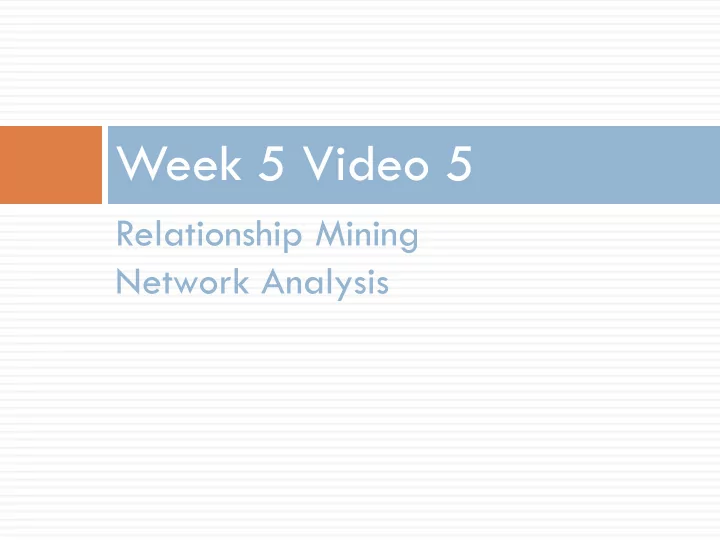

Week 5 Video 5 Relationship Mining Network Analysis
Today’s Class ¨ Network Analysis
Network Analysis ¨ Analysis of anything that can be seen as connections between nodes ¨ Most common – social networks ¤ Connections between friends on the internet ¤ Connections between students in a class ¤ Connections between collaborators in a work project
Network Analysis ¨ Could also be considered structure discovery ¨ Placed here in the course because of how it’s typically used in practice
General Postulates of Network Analysis ¨ There are things, referred to as nodes or vertices ¨ Nodes have connections to other nodes, referred to as ties or links ¨ Nodes can have different types or identities ¨ Links can have different types or identities ¨ Links can have different strengths
Example: (Student work groups – Kay et al., 2006)
Example: (Student work groups – Kay et al., 2006) nodes
Example: (Student work groups – Kay et al., 2006) ties
Example: (Student work groups – Kay et al., 2006) Strong ties Weak ties
Which student group works together better?
Which is the most collaborative pair?
Which is the most collaborative pair?
Who is the most collaborative student?
Who is the most collaborative student?
Types ¨ In a graph of classroom interactions, there could be several different types of nodes ¤ Teacher ¤ TA ¤ Student ¤ Project Leader ¤ Project Scribe
Types ¨ In a graph of classroom interactions, there could be several types of links ¤ Leadership role (X leads Y) ¤ Working on same learning resource ¤ Helping act ¤ Criticism act ¤ Insult ¤ Note that links can be directed or undirected
Strength ¨ In a graph of classroom interactions, links could be stronger or weaker due to ¤ Intensity of act ¤ Frequency of act
Network Analysis ¨ Use network graphs to study the patterns and regularities of the relationships between the nodes
Density ¨ Proportion of possible lines that are actually present in graph ¨ What is the density of these graphs?
Density ¨ Proportion of possible lines that are actually present in graph ¨ What is the density of these graphs? 100% 3/15= 20%
Density ¨ Could be used to figure out how collaborative a class is overall
Reachability ¨ A node is “reachable” if a path goes from any other node to it ¨ Which nodes are unreachable?
Reachability ¨ A node is “reachable” if a path goes from any other node to it ¨ Which nodes are unreachable?
Reachability ¨ Are there any students who don’t collaborate with anybody?
Geodesic Distance ¨ The number of edges between one node N and another node M, in the shortest path connecting them
Student social network: (Dawson, 2008)
What is the geodesic distance?
Geodesic distance = 4 1 2 3 4
What is the geodesic distance?
Geodesic Distance = 7 5 6 7 4 3 1 2
What is the geodesic distance?
Geodesic Distance = Infinite
Quiz What is the geodesic distance? 6 A) 7 B) 8 C) 9 D)
Geodesic Distance ¨ How many people does an idea need to go through to get between people?
Flow ¨ How many possible paths are there between node N and node M, that do not repeat a node?
What is the flow?
1
2
3
Flow ¨ How many possible paths are there for an idea to go between people?
Centrality ¨ How important is a node within the graph? ¨ Which kids are the popular or influential kids?
Centrality ¨ Four common measures ¤ Degree centrality ¤ Closeness centrality ¤ Betweeness centrality ¤ Eigenvector centrality
Nodal Degree ¨ Number of lines that connect to a node
The node with the highest nodal degree
Nodal Degree ¨ Indegree: number of lines that come into a node ¨ Outdegree: number of lines that come out of a node
Closeness ¨ A node N’s closeness is defined as the sum of its distance to other nodes ¨ The most central node in terms of closeness is the node with the lowest value for this metric ¨ Note that strengths can be used as a distance measure for calculating closeness ¤ Higher strength = closer nodes
Betweenness ¨ Betweeness centrality for node N is computed as: ¨ The percent of cases where ¨ For each pair of nodes M and P (which are not N) ¤ The shortest path from M to P passes through N
What is this node’s betweenness
Betweenness is high; each group can only get to other groups through this point
What is this node’s betweenness?
Low, only one point connects through it
What is this node’s betweenness?
Betweenness = 0
Reciprocity ¨ What percentage of ties are bi-directional? ¤ Can be computed as number of bi-directional ties over total number of connected pairs
Eigenvector Centrality ¨ Complex math, but assigns centrality to nodes through recursive process where ¨ More and stronger connections are positive ¨ Connections to nodes with higher eigenvector centrality contribute more than connections to nodes with lower eigenvector centrality
Eigenvector Centrality ¨ A key part of the original PageRank in Google
Lots of uses ¨ There are lots of uses for network analysis ¨ But particularly useful for studying collaboration ¤ Group-based learning ¤ Teacher collaboration ¤ Networks of influence n Why do some educational interventions seem to be dominant in specific regions?
Next lecture: Epistemic Networks
Recommend
More recommend